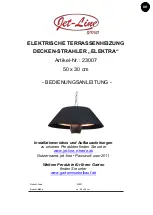
S 30
18
water inlet of the tank and install a drain valve “B”, which can only be opened with a tool, on the side. The safety valve
combination “C” must then be connected to the other connector of the T-piece.
In the presence of particularly hard waters (>14 °dH), there will be a considerable and rapid formation of limescale
inside the appliance, with a consequent loss in efficiency and damage to the electric heating element. The appliance
must be decalcified regularly. In order to reduce limescale, you can soften the water in the cold water inlet by an
appropriate drinking water suitable device.
For the correct functioning of the galvanic protection system, it is necessary that the water is not softened below a
value of 8.4 °dH.
If the water hardness falls below a minimum of 6.7 °dH, the use of the device is no longer permissible!
Closed operation
Mount the appliance close to the tap from which the most hot water will be extracted.
A design proofed safety valve combination is to be installed. In addition, if water pressure exceeds 0.48 MPa (4.8 bar),
a pressure reducing valve is to be installed and adjusted accordingly. No shut-off valves may be installed between the
safety modules and the reservoir. Discharge from the safety valve must always be open. The safety valve combination
for closed operation must be accredited.
Note:
In compliance with the Energy Conservation Act, the temperature of the water heater should be limited to 60 °C
for hot water pipes which exceeds a length of 5 meters.
Open operation
A suitable mixer tap should be installed for the open discharge operation. The tap outlet should always be kept free
from obstructions. Only use CLAGE flow regulator for open storage water heater. A backflow prevention device should
be connected to the cold water inlet.
Electrical connection
Structural prerequisites
• The appliance must be connected to a professionally installed, earthed socket outlet via the connecting cable
(length approx. 130 cm). Multiple connectors must not be used!
• The electric wiring should not be injured and must only be replaced by a specialist and only by original spare parts.
• An all-pole disconnecting device (e.g. via fuses) with a contact opening width of at least 3 mm per pole should be
provided at the installation end.
• To protect the appliance, a fuse element must be fitted with a tripping current commensurate with the nominal
current of the appliance.
1. Disconnect the power supply e.g. via fuses and ensure that they cannot unintendedly be switched on.
2. Plug in the safety plug of the connecting cable.
Check that the system is suitable for the maximum power absorbed by the water heater (please refer to the data
plate).
5. Installation







































